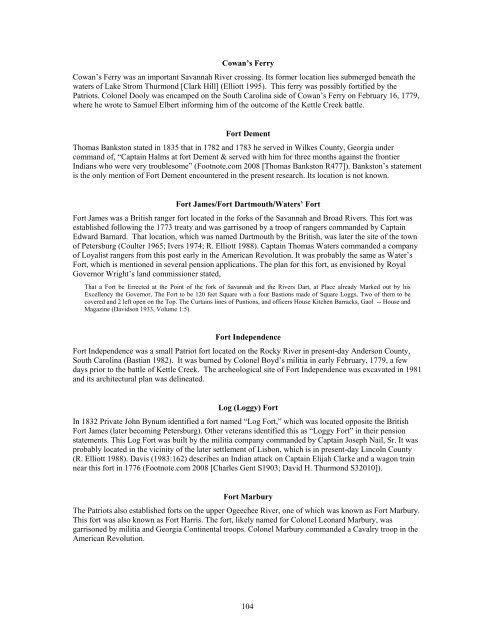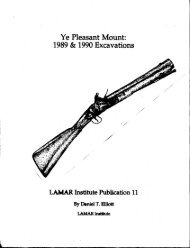Stirring Up a Hornet's Nest: - UGA Laboratory of Archaeology ...
Stirring Up a Hornet's Nest: - UGA Laboratory of Archaeology ...
Stirring Up a Hornet's Nest: - UGA Laboratory of Archaeology ...
Create successful ePaper yourself
Turn your PDF publications into a flip-book with our unique Google optimized e-Paper software.
Cowan’s Ferry<br />
Cowan’s Ferry was an important Savannah River crossing. Its former location lies submerged beneath the<br />
waters <strong>of</strong> Lake Strom Thurmond [Clark Hill] (Elliott 1995). This ferry was possibly fortified by the<br />
Patriots. Colonel Dooly was encamped on the South Carolina side <strong>of</strong> Cowan’s Ferry on February 16, 1779,<br />
where he wrote to Samuel Elbert informing him <strong>of</strong> the outcome <strong>of</strong> the Kettle Creek battle.<br />
Fort Dement<br />
Thomas Bankston stated in 1835 that in 1782 and 1783 he served in Wilkes County, Georgia under<br />
command <strong>of</strong>, “Captain Halms at fort Dement & served with him for three months against the frontier<br />
Indians who were very troublesome” (Footnote.com 2008 [Thomas Bankston R477]). Bankston’s statement<br />
is the only mention <strong>of</strong> Fort Dement encountered in the present research. Its location is not known.<br />
Fort James/Fort Dartmouth/Waters’ Fort<br />
Fort James was a British ranger fort located in the forks <strong>of</strong> the Savannah and Broad Rivers. This fort was<br />
established following the 1773 treaty and was garrisoned by a troop <strong>of</strong> rangers commanded by Captain<br />
Edward Barnard. That location, which was named Dartmouth by the British, was later the site <strong>of</strong> the town<br />
<strong>of</strong> Petersburg (Coulter 1965; Ivers 1974; R. Elliott 1988). Captain Thomas Waters commanded a company<br />
<strong>of</strong> Loyalist rangers from this post early in the American Revolution. It was probably the same as Water’s<br />
Fort, which is mentioned in several pension applications. The plan for this fort, as envisioned by Royal<br />
Governor Wright’s land commissioner stated,<br />
That a Fort be Errected at the Point <strong>of</strong> the fork <strong>of</strong> Savannah and the Rivers Dart, at Place already Marked out by his<br />
Excellency the Governor, The Fort to be 120 feet Square with a four Bastions made <strong>of</strong> Square Loggs, Two <strong>of</strong> them to be<br />
covered and 2 left open on the Top. The Curtains lines <strong>of</strong> Puntions, and <strong>of</strong>ficers House Kitchen Barracks, Gaol -- House and<br />
Magazine (Davidson 1933, Volume 1:5).<br />
Fort Independence<br />
Fort Independence was a small Patriot fort located on the Rocky River in present-day Anderson County,<br />
South Carolina (Bastian 1982). It was burned by Colonel Boyd’s militia in early February, 1779, a few<br />
days prior to the battle <strong>of</strong> Kettle Creek. The archeological site <strong>of</strong> Fort Independence was excavated in 1981<br />
and its architectural plan was delineated.<br />
Log (Loggy) Fort<br />
In 1832 Private John Bynum identified a fort named “Log Fort,” which was located opposite the British<br />
Fort James (later becoming Petersburg). Other veterans identified this as “Loggy Fort” in their pension<br />
statements. This Log Fort was built by the militia company commanded by Captain Joseph Nail, Sr. It was<br />
probably located in the vicinity <strong>of</strong> the later settlement <strong>of</strong> Lisbon, which is in present-day Lincoln County<br />
(R. Elliott 1988). Davis (1983:162) describes an Indian attack on Captain Elijah Clarke and a wagon train<br />
near this fort in 1776 (Footnote.com 2008 [Charles Gent S1903; David H. Thurmond S32010]).<br />
Fort Marbury<br />
The Patriots also established forts on the upper Ogeechee River, one <strong>of</strong> which was known as Fort Marbury.<br />
This fort was also known as Fort Harris. The fort, likely named for Colonel Leonard Marbury, was<br />
garrisoned by militia and Georgia Continental troops. Colonel Marbury commanded a Cavalry troop in the<br />
American Revolution.<br />
104










